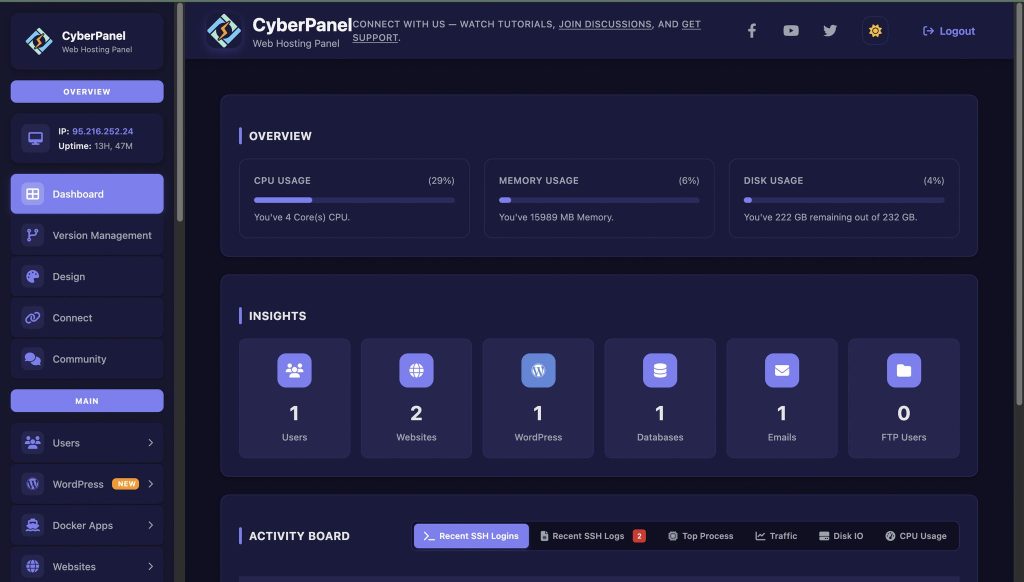When you are using Linux, it’s obvious to manage multiple processes at a time. Sometimes, when you start a command and realize that you will need it to continue running even after closing the terminal. Right? This is where the disown Linux command helps out. This command allows you to remove jobs from the terminal’s process group. It will ensure that they are not killed when you log out or close the session.
Many Linux users confuse & disown Linux usage or rely only on nohup, the disown command in Linux is a more flexible tool. It provides developers and system administrators with a reliable way to manage background processes effectively. In this guide, we will learn everything about the disown Linux command.
Let’s go together!
What is the Disown Linux Command?
The Linux disown command removes a process from the shell’s job table. It means it will not receive signals when the shell session ends. This thing allows the process to continue running in the background.
Syntax of the Disown Command Linux
Here is the general syntax of disown command in Linux:
disown [options] [job_spec]
- Without arguments, it disowns the most recent background job.
[job_spec]can be used to specify a job ID.
How to Use & disown Linux Command?
Here is how you can run a job in the background and disown it:
Get exclusive access to all things tech-savvy, and be the first to receive
the latest updates directly in your inbox.
command &
disown
command &runs the process in the background.disowndetaches it from the terminal.
Now, when you close the terminal, it will not stop the process.
How to Install Disown Linux?
Now, we are going to discuss the methods of installing disown Linux. It is the feature that is built into the most modern shells like bash and zsh. So, you have not required any extra installation. However, your shell should be updated.
To Update Bash:
sudo apt update && sudo apt install --only-upgrade bash
To Update Zsh:
sudo apt update && sudo apt install --only-upgrade zsh
How to Uninstall Disown Linux?
Since disown is part of the shell, you cannot uninstall it separately. The only way is to remove or replace the shell itself, but that’s not recommended.
Comparison of Background Process Methods in Linux
| Metho | Command Example | Persists After Logout | Can Reattach? | Notes |
|---|---|---|---|---|
& (ampersand) | python script.py & | ❌ No | ✅ Yes (with fg or bg) | Runs process in background but ends if you log out. |
nohup | nohup python script.py & | ✅ Yes | ❌ No | Ignores hangup signals; output saved to nohup.out. |
disown (with bash) | disown -h %1 | ✅ Yes | ❌ No | Removes process from shell job table, keeps running after logout. |
screen | screen -S myjob | ✅ Yes | ✅ Yes | Full terminal multiplexer; allows reattaching sessions later. |
tmux | tmux new -s myjob | ✅ Yes | ✅ Yes | Similar to screen, modern and feature-rich session manager. |
Using the disown Command in Linux: Practical Examples
Here is how you can use the disown command in Linux:
| Command | Purpose | When to Use |
|---|---|---|
& disown | Run + disown immediately | For quick background tasks |
disown -h %1 | Prevents HUP signal only | If you want job still tracked but safe |
disown -a | Disowns all jobs | When running many background processes |
Role of CyberPanel

When you are hosting a website, background jobs like cron scripts or data migration processes must run reliably. CyberPanel is a next-gen web hosting control panel that complements disown Linux. It provides you with a user-friendly way to monitor and manage jobs on the server. The disown command will handle process detachment, and CyberPanel will ensure that you can track performance, logs, and uptime efficiently.
People Also Ask
Is it possible to reattach a process after using the disown command in Linux?
No, it is not possible. Once you disown a process in Linux, it will be completely detached from the shell.
Does disown in Linux survive a system reboot?
No. The disown only prevents you from being killed when you close the terminal. To keep processes running after a reboot, use services like systemd or tools like cron.

Is there any way to check if a process is still running after disowning it?
Yes. You can use the ps -ef | grep <process_name> or pgrep <process_name> command to verify if the process is active. Since it is no longer tied to the shell, it won’t show in jobs.
Is there any difference between disown and nohup in Linux?
Yes, both are used together yet are different. The disown removes a process from shell job control, while nohup prevents processes from being terminated when a session ends.
Final Thoughts!
To sum up, the disown Linux command is a powerful way to keep processes running independently of your terminal session. When you combine it with background operations like &, you gain full control of jobs even after logout. Moreover, you can combine it with CyberPanel to create a perfect balance of automation and control.
Ready to supercharge your Linux skills? Explore the disown Linux command and see the difference in process handling today!



